The quest for sparkling clean dishes can feel surprisingly complex given the vast array of products lining store shelves. From liquids and powders to pods and pucks, choosing the right dishwashing product for the job – whether washing by hand or using an automatic dishwasher – requires understanding how these cleaners work and what sets them apart.
Covered within are manual dish soaps, automatic dishwasher detergents, essential aids like rinse agents and machine cleaners, and even insights into when professional cleaning services might be the best solution. Selecting the appropriate product is crucial not only for achieving spotless results but also for protecting dishes, maintaining appliance health, ensuring skin safety during handwashing, and considering environmental impact.
Contact us!
The Science Behind the Sparkle: How Dishwashing Products Clean
At its core, dishwashing is about removing food soils – primarily grease, starches, and proteins – from surfaces using water, mechanical action (scrubbing or spraying), and chemical assistance from detergents. Several key types of ingredients work together to achieve this clean.
Surfactants (The Grease Lifters)
Surfactants, or surface-active agents, are the workhorses of many cleaning products, especially manual dish soaps. Their power lies in their unique molecular structure: one end of the molecule is hydrophilic (attracted to water), while the other end is hydrophobic (repels water but is attracted to oil and grease).
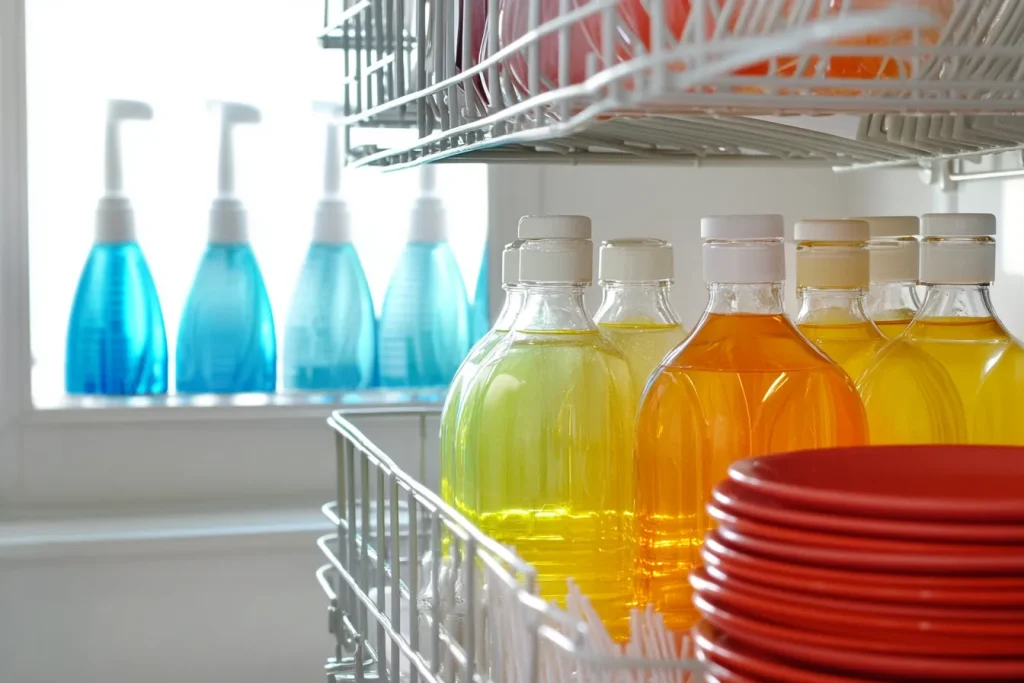
When introduced into water, surfactants reduce the water’s surface tension, allowing it to spread more easily and wet surfaces thoroughly. More importantly, they act as emulsifiers. The hydrophobic tails attach themselves to grease and oil particles on dirty dishes. The hydrophilic heads remain facing the surrounding water. This forms tiny structures called micelles, essentially encapsulating the grease and lifting it off the dish surface.
Once suspended in the water, the emulsified grease can be easily rinsed away. This mechanism is fundamental to how hand dish soaps tackle greasy pots and pans, working in concert with the physical force of scrubbing.
Enzymes (The Food Digesters)
Automatic dishwasher detergents, operating in an environment without manual scrubbing, rely heavily on enzymes to break down stubborn food soils. Enzymes are biological catalysts – proteins that speed up specific chemical reactions without being consumed in the process. In detergents, they target large food molecules, breaking them into smaller, more water-soluble pieces that can be washed away. A tiny amount of enzyme can break down a large quantity of soil.
The primary enzymes found in dishwasher detergents include:
- Proteases: These enzymes target protein-based soils, such as dried egg, meat residues, and dairy films. Historically, proteases were among the first enzymes used effectively in detergents.
- Amylases: These break down starch-based soils like pasta, rice, potatoes, sauces, gravy, and ice cream. Starch, if not broken down, can act as a binder for other dirt.
Lipases (for fats) and other enzymes like cellulases or mannanases may also be included, though proteases and amylases are key for dishwashing. Enzymes are particularly effective on tough, dried-on, or baked-on food, reducing the need for pre-scrubbing and enabling cleaning under milder conditions, which can also help protect glassware.
Builders (The Water Softeners & Performance Boosters)
Builders play a crucial role, especially in automatic dishwasher detergents, by managing water hardness. Hard water contains high levels of dissolved minerals, primarily calcium (Ca2+) and magnesium (Mg2+) ions. These ions interfere with the cleaning process by reacting with surfactants and forming soap scum, reducing overall effectiveness. Builders counteract this by ‘tying up’ these hardness minerals, either through chelation (binding them) or precipitation (causing them to fall out of solution).
Beyond softening water, builders also contribute to alkalinity (high pH), which aids in breaking down fats and oils, and provide buffering capacity to maintain the optimal pH for enzyme activity and overall cleaning.
Historically, phosphates (like STPP – sodium tripolyphosphate) were widely used and highly effective builders. However, due to environmental concerns – phosphates contribute to eutrophication (excessive algal growth) in waterways – their use has been restricted or banned in many regions since around 2010.
 Modern detergents now use phosphate alternatives, such as sodium citrate, citric acid, sodium carbonate, sodium silicate, polycarboxylates, and newer complexing agents like IDS (Iminodisuccinate), MGDA (Methylglycinediacetic acid), and GLDA (Glutamic acid diacetic acid). While more environmentally friendly, these alternatives are sometimes considered less effective than phosphates, placing greater importance on the performance of enzymes, surfactants, and rinse aids in modern formulations.
Modern detergents now use phosphate alternatives, such as sodium citrate, citric acid, sodium carbonate, sodium silicate, polycarboxylates, and newer complexing agents like IDS (Iminodisuccinate), MGDA (Methylglycinediacetic acid), and GLDA (Glutamic acid diacetic acid). While more environmentally friendly, these alternatives are sometimes considered less effective than phosphates, placing greater importance on the performance of enzymes, surfactants, and rinse aids in modern formulations.
The distinct operating environments and cleaning challenges of handwashing versus automatic dishwashing dictate fundamentally different product formulations. Hand dish soaps must generate sufficient foam and rely heavily on surfactants, coupled with manual energy, to lift grease.
Crucially, they must also be relatively mild to avoid excessively drying or irritating skin. Automatic dishwasher detergents, conversely, operate in a closed, high-heat, high-pressure water environment where foam is detrimental; excessive suds interfere with the spray arm action and can even cause the machine to leak or malfunction. Therefore, automatic formulations are designed to be low- or non-foaming.
They compensate for the lack of manual scrubbing by employing a potent combination of enzymes to break down food chemically, builders to optimize water conditions and pH, and specialized low-foaming surfactants, often alongside bleach for sanitization and stain removal. This inherent difference in required properties and cleaning mechanisms is why hand dish soap and automatic dishwasher detergent are not interchangeable and why using the wrong product can lead to poor results or appliance damage.
Handwashing Heroes: Manual Dish Soaps
Manual dish soaps are formulated specifically for washing dishes, glassware, cutlery, and cookware in a sink, relying on the combination of chemical action and physical scrubbing.
Mechanism of Action
The primary cleaning mechanism involves surfactants emulsifying grease and suspending food particles, making them easy to rinse away with warm water. The mechanical energy provided by a sponge, brush, or cloth is essential for dislodging tougher residues.
Formulations: Liquid vs. Solid
Manual dishwashing detergents come in two main forms:
- Liquid Dish Soap: This is the most prevalent form. Typical formulations contain water as the main component, various surfactants (anionic like LAS/DDBSA and SLES, nonionic like Cocamide DEA, and amphoteric like Cocamidopropyl Betaine), sodium chloride (salt) to adjust viscosity, preservatives to prevent microbial growth, and fragrances and dyes for aesthetic appeal. The concentration and blend of surfactants vary significantly between economy, medium, and premium products. Higher concentrations generally lead to better grease cutting, more voluminous and stable foam, and higher viscosity, but also increase the cost.
- Solid Dish Soap (Bars/Pucks): Gaining popularity as a sustainable alternative, solid dish soaps are concentrated blocks of soap. To use them, one typically wets a sponge, brush, or cloth and rubs it on the bar to generate lather, then proceeds to scrub the dishes. Rinsing follows as usual. The bar should be stored on a soap dish or tray that allows it to drain and dry between uses. Users might find they need to apply slightly more physical effort (“elbow grease”) compared to highly concentrated liquids.
- Advantages: Solid soaps often come with minimal or zero plastic packaging (package-free or in recyclable paperboard), significantly reducing plastic waste. Being concentrated and containing little water, they are lighter and smaller to ship, reducing transportation emissions. Many are formulated with simpler, plant-based ingredients, often free from dyes, synthetic fragrances, and preservatives. They can also be very long-lasting, potentially offering better cost-effectiveness over time compared to liquids.
- Disadvantages: Requires a slight adjustment in technique compared to liquids. Initial lather might seem less abundant until the user gets accustomed to loading the sponge/brush sufficiently. Requires appropriate storage to prevent the bar from becoming mushy.
Table 1: Liquid vs. Solid Hand Dish Soap Comparison
| Feature | Liquid Dish Soap | Solid Dish Soap (Bar/Puck) |
|---|---|---|
| Packaging | Typically single-use plastic bottles | Often package-free or in recyclable/compostable paperboard; minimal plastic waste |
| Environmental Impact | Higher plastic waste; shipping heavier water content increases emissions | Lower plastic waste; reduced shipping emissions due to concentration |
| Ease of Use | Familiar; easy to dispense desired amount | Requires rubbing wet sponge/brush on bar; slight learning curve |
| Lather Generation | Typically high and immediate lather | Can require more effort initially to build rich lather |
| Cost-Effectiveness | Variable; concentrated formulas exist, but easy to overuse | Can be very long-lasting, potentially more cost-effective per use |
| Storage | Bottle sits near sink | Requires a draining soap dish or surface to prevent sogginess |
| Ingredient Focus (Often) | May contain synthetic surfactants, preservatives, dyes, fragrances | Often emphasizes simpler, plant-based, dye-free, preservative-free formulations |
Effective Handwashing Techniques
Following a systematic approach can make hand dishwashing more efficient and effective. Based on guidelines from the American Cleaning Institute (ACI), the recommended steps are :
- Prep: Scrape excess food off dishes into the trash or compost. Avoid pouring grease down the drain as it can cause clogs. For heavily soiled items with baked-on food, soak them first in hot water with a bit of detergent or baking soda for 15-30 minutes.
- Fill: Fill a clean sink or dishpan with clean, hot water. Add the recommended amount of dish soap (check the label, especially for concentrates). Avoid overcrowding the sink; adding a few dishes at a time allows for brief soaking. Change the water if it becomes too cool, greasy, or loses its suds.
- Wash: Wash items in order, starting with the least soiled: glasses, cups, and flatware first, followed by plates and bowls, and finally, the dirtiest items like pots and pans. Keep items submerged while scrubbing for easier cleaning. Pull items out periodically to check for missed spots. Handle knives carefully, washing them one at a time and placing them safely aside or in a drying rack handle-up.
- Rinse: Rinse away all soap suds and residue thoroughly under clean, hot running water. A double sink is useful, with one side for washing and the other for rinsing. Ensure the insides of cups, bowls, and glasses are well-rinsed.
- Dry: Air drying on a clean rack is often easiest. However, towel drying with a clean, dry towel can prevent spots or film on glassware and flatware. Change the towel if it becomes damp. Paper towels can be effective for drying greasy pots and pans.
- Clean Up: After finishing, rinse the sink, dishpan, and drainer. Rinse and wring out dishcloths and sponges, allowing them to air dry thoroughly to discourage bacterial growth. Replace sponges and cloths frequently.
Some users prefer the “neat” method, applying detergent directly to the sponge or dish, while others use the “diluting” method described above.
A crucial aspect of manual dish soap formulation is achieving a careful balance. The product must possess sufficient cleaning power, utilizing effective surfactants like LAS and SLES to cut through grease and lift food particles. However, unlike automatic detergents, hand soaps are used in direct contact with the skin.
Surfactants that are overly aggressive in stripping oils can remove the skin’s natural protective lipid barrier, leading to dryness, irritation, and even cracking with frequent use. Consequently, formulators often select milder surfactants, use combinations that enhance mildness (like incorporating amphoteric surfactants such as Cocamidopropyl Betaine), or add moisturizing agents to mitigate potential skin dryness.
This inherent need for skin compatibility distinguishes hand soaps significantly from the harsher, high-pH, bleach-containing formulations often found in automatic dishwasher detergents, which prioritize cleaning power over mildness. This explains why occasional handwashing with dish soap is generally acceptable (though potentially drying for sensitive individuals), while using automatic detergent for handwashing is strongly discouraged due to its harshness.
Automatic Dishwashing: Decoding Your Options
Automatic dishwashing detergents are specialized products designed exclusively for use in dishwasher machines. Their formulation and function differ significantly from manual dish soaps.
The Critical Difference: Foam Control
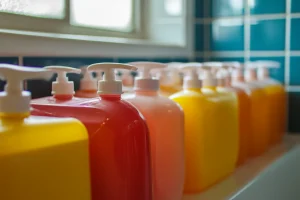 The single most critical distinction is foaming behavior. Manual dish soaps are formulated to produce abundant, stable suds, which users often associate with cleaning power and which help lift grease during scrubbing. In an automatic dishwasher, however, these suds are highly problematic. The high-pressure water jets spraying inside the machine will whip high-foaming soap into an excessive lather.
The single most critical distinction is foaming behavior. Manual dish soaps are formulated to produce abundant, stable suds, which users often associate with cleaning power and which help lift grease during scrubbing. In an automatic dishwasher, however, these suds are highly problematic. The high-pressure water jets spraying inside the machine will whip high-foaming soap into an excessive lather.
This foam can cushion the impact of the water jets, drastically reducing cleaning effectiveness. Worse, it can overflow out of the machine, potentially causing water damage to floors and cabinetry, and can even damage the dishwasher’s pump and seals.
For this reason, automatic dishwasher detergents are meticulously formulated to be low-foaming or non-foaming. They achieve cleaning through a combination of chemical action (enzymes, builders, bleach, specialized surfactants), high water temperatures, and the mechanical force of the water spray, not through suds. It cannot be stressed enough: Never use manual dish soap in an automatic dishwasher.
Choosing Your Champion: Powder, Liquid, Gel, Tablets, or Pods/Pacs?
Automatic dishwasher detergents are available in several formats, each with its own set of advantages and disadvantages:
- Powder: The traditional format, often the most economical option per wash. Powders frequently contain bleach and a good concentration of builders, making them particularly effective in areas with hard water for preventing spots and limescale buildup. They allow for flexible dosing, though measuring can sometimes be messy. A potential drawback is that powders may not dissolve completely in very short or low-temperature cycles, potentially leaving residue or clogging the dispenser.
- Liquid/Gel: Liquids and gels are easy to pour and measure, offering dosage flexibility similar to powders. They dissolve readily even in cooler water. However, they are generally considered less effective than powders or pods/tablets, particularly on heavily soiled dishes or tough stains like baked-on food. Some user reports and product reviews rank gels as the least effective format.
- Tablets: These are essentially compressed blocks of powder detergent, offering the convenience of a pre-measured dose. This eliminates guesswork and potential mess. However, like powders, they might not dissolve fully in shorter or cooler cycles. They offer no dosage flexibility for smaller loads. Additionally, using a tablet in the main dispenser prevents the user from adding detergent to the pre-wash compartment, potentially reducing cleaning effectiveness on heavily soiled loads.
- Pods/Pacs: These are single-dose units, typically containing concentrated liquid, gel, powder, or a combination thereof, encased in a thin, water-soluble film (usually Polyvinyl Alcohol – PVA). Pods offer maximum convenience – simply place one in the dispenser. They are often formulated with multiple components (e.g., separate chambers for enzymes, surfactants, and rinse aid boosters) and are generally considered highly effective, often outperforming other formats, especially in preventing filming. However, they are typically the most expensive option per wash. Like tablets, they offer no dosage flexibility. Environmental concerns exist regarding the plastic packaging they often come in and the potential for the dissolvable PVA film to contribute to microplastic pollution, although this is debated. Some pods may also fail to dissolve completely, especially if the dispenser is blocked or the cycle is very short.
Table 2: Automatic Dishwasher Detergent Types Compared
| Feature | Powder | Liquid/Gel | Tablets | Pods/Pacs |
|---|---|---|---|---|
| Effectiveness (General) | Good to Very Good | Fair to Good; Gels often ranked lower | Good to Very Good | Very Good to Excellent; Often best performance |
| Tough Stains | Generally effective, especially with bleach | Less effective than powders or pods | Generally effective | Often highly effective due to concentration/multi-chamber formulas |
| Hard Water Performance | Often best choice due to builders/bleach; helps prevent limescale | May struggle more; look for specific hard water formulas | Can be effective; depends on formulation | Often contain water softening agents; effective |
| Convenience | Requires measuring; can be messy | Easy to pour and measure | Pre-measured; clean handling | Maximum convenience; pre-measured, no direct contact |
| Cost per Load | Typically lowest | Low to Medium | Medium to High | Typically highest |
| Dosage Flexibility | High; easy to adjust amount | High; easy to adjust amount | None; fixed dose | None; fixed dose |
| Dissolvability Issues | Can occur in cold/short cycles | Generally dissolves well | Can occur in cold/short cycles | Can occur if dispenser blocked or cycle too short |
| Environmental Impact (Pkg/Form) | Cardboard box often recyclable; formula impact varies | Plastic bottle often recyclable; formula impact varies; less concentrated | Often minimal individual wrapping; formula impact varies | Outer packaging varies (bag/box); individual wrappers/dissolvable film raise questions |
Inside the Formula: Enzymes and Builders Revisited
Regardless of the format, the cleaning power of automatic dishwasher detergents hinges on their core ingredients. Enzymes like protease (for proteins) and amylase (for starches) are essential for chemically dismantling food soils in the absence of scrubbing. Builders remain critical for managing water hardness, ensuring surfactants and enzymes can work effectively, and maintaining the alkaline environment needed for optimal cleaning.
The transition away from phosphates means modern builders like citrates, carbonates, silicates, and specialized chelating agents are now standard.
Hard vs. Soft Water: Matching Detergent to Your Water Type
Water hardness dramatically affects dishwasher performance.
- Hard Water: High mineral content counteracts detergent effectiveness and can leave behind unsightly white spots, streaks, or a cloudy film on dishes, particularly glassware. Over time, it also causes limescale buildup inside the dishwasher itself, potentially impairing function. For hard water, powder detergents are often recommended due to their typical composition (higher builder/bleach content). Alternatively, look for any detergent format specifically labeled for hard water use. Using a rinse aid becomes almost essential in hard water conditions.
- Soft Water: Low mineral content means detergents work very efficiently. This can be advantageous but also carries risks. Over-dosing detergent in soft water can lead to excessive foam (even with low-foam formulas) or leave residue. More seriously, the combination of soft water, high heat, and potent detergents can cause permanent etching (cloudiness) on glassware. With soft water, it may be possible to use slightly less detergent than recommended. Liquid detergents or pods might perform well. Careful dosing and potentially avoiding extra-hot cycles for delicate glassware are advisable.
If unsure about water hardness, simple test strips are available, or information can often be obtained from the local municipal water supplier.
Choosing an automatic dishwasher detergent format involves navigating a significant trade-off between convenience, cost, and control. Pods and tablets undeniably offer the ultimate ease of use: simply place one dose in the machine with no measuring or mess.
This convenience, combined with often highly effective multi-component formulations, makes them very popular. However, this comes at a premium price per wash cycle. Furthermore, the fixed-dose nature eliminates the ability to adjust the amount of detergent based on the size of the load or how dirty the dishes are – a full dose is used whether washing a few lightly soiled cups or a full load of greasy pans. Powders and liquids/gels, conversely, provide complete dosage flexibility, allowing users to tailor the amount used, potentially saving money on smaller or cleaner loads. They also generally have a lower cost per wash.
The downside is the need for manual measuring, the potential for spills or mess, and the risk of under- or over-dosing, which can lead to poor cleaning, residue, or waste. Ultimately, the “best” format depends on individual priorities: budget constraints, the value placed on convenience, typical load sizes and soil levels, and environmental considerations regarding packaging.
Beyond Detergent: Essential Dishwasher Aids
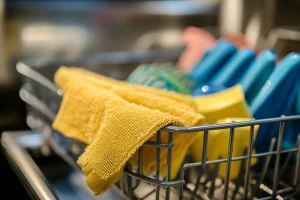 While detergent is the primary cleaning agent, several other products play vital roles in achieving optimal dishwashing results and maintaining the health of the machine.
While detergent is the primary cleaning agent, several other products play vital roles in achieving optimal dishwashing results and maintaining the health of the machine.
Rinse Aids: The Secret to Spot-Free Drying
- Purpose: Rinse aids are liquids automatically dispensed during the final rinse cycle. Their main functions are to accelerate drying, prevent water spots and streaks, and reduce filming on dishes and glassware.
- Mechanism: They work by introducing specialized low-foaming surfactants into the final rinse water. These surfactants dramatically lower the surface tension of the water. Instead of beading up into individual droplets (which leave behind mineral deposits as they evaporate, causing spots), the water forms a thin, uniform sheet that runs off surfaces quickly and evenly. This “sheeting action” leads to faster, more uniform drying with fewer residual marks.
- Composition: Key ingredients are low-foaming nonionic surfactants, along with solubilizing agents (hydrotropes, if needed) to keep them dissolved, and potentially acids or salts to optimize performance.
- Importance: Rinse aid use is highly recommended, particularly in areas with hard water, as it directly combats the spotting and filming caused by mineral deposits. Since the reduction of phosphates in detergents, which also helped prevent spotting, rinse aids have become even more crucial for achieving satisfactory drying and appearance. Even when using “all-in-one” detergent pods or tablets that claim to include rinse aid, the amount is often small, and using a separate liquid rinse aid in the dispenser typically yields better results, especially for drying performance.
- Usage: Fill the dedicated rinse aid dispenser in the dishwasher door according to the manufacturer’s instructions. Most dishwashers have an adjustable dosage setting; if dishes show spots or are wet, increase the setting. If excessive foam or greasy residue appears, decrease the setting. The machine will usually indicate when the dispenser needs refilling.
- Substitutes: Using white vinegar as a substitute is strongly discouraged. While its acidity might offer some spot-reducing effect, it can degrade rubber gaskets, seals, and hoses within the dishwasher over time, potentially leading to leaks or damage. Stick to commercially formulated rinse aids designed for dishwasher use.
Dishwasher Cleaners: Maintaining Your Machine’s Health
- Purpose: These products are not for cleaning dishes but for cleaning the dishwasher itself. Over time, grease, food particles, soap scum, and especially limescale (mineral buildup from hard water) can accumulate in hidden parts of the machine, including the filter, spray arms, pipes, and heating element. This buildup can lead to unpleasant odors, reduce cleaning performance, and potentially shorten the appliance’s lifespan.
- Mechanism: Dishwasher cleaners typically contain acids (like citric acid) to dissolve mineral deposits (limescale) and strong detergents or surfactants to break down accumulated grease and soap scum.
- Usage: Dishwasher cleaners should be used periodically in an empty machine. Follow the specific product’s instructions: some come as tablets placed in the detergent dispenser or on the bottom of the tub, while others are liquid formulations in bottles with a wax seal that melts during the cycle, designed to be placed upside down in a rack. Run a normal, hot wash cycle without any dishes.
- Frequency: A monthly cleaning is generally recommended for preventative maintenance, or more often if hard water causes noticeable buildup or odors develop. Some recommend cleaning every 30 wash cycles.
Pre-Soak Aids / Pre-Wash Detergents
- Purpose: These are used to tackle heavily soiled dishes with stubborn, dried-on, or baked-on food residues, particularly proteins and starches, making them easier to remove during the main wash cycle.
- Types & Mechanism:
- Manual Presoak Products: These are often enzyme-containing formulas (solid or liquid) designed for soaking pots, pans, or flatware in a separate tub or sink before loading them into the dishwasher. The enzymes begin breaking down tough soils like baked-on cheese or egg.
- Using the Pre-Wash Cycle: Most dishwashers perform a short pre-wash phase at the beginning of a cycle, rinsing dishes with water before the main wash begins. Adding a small amount of your regular automatic dishwasher detergent (powder or liquid – never manual dish soap) to the pre-wash compartment (if your machine has one) or simply tossing it onto the bottom of the dishwasher door before starting the cycle can significantly boost cleaning. This initial dose of detergent helps remove loose debris and grease during the pre-wash, preparing dishes for a more effective main wash.
- Benefit: Utilizing presoaks or the pre-wash function effectively can greatly improve results on challenging loads and often makes rigorous pre-rinsing of dishes under the tap unnecessary, saving water and time.
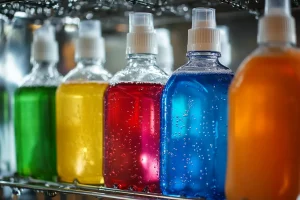 Achieving consistently excellent dishwashing results often requires more than just selecting a good detergent. It involves adopting a system approach. While the detergent handles the primary task of soil removal, its performance is heavily influenced by factors like water chemistry and the cleanliness of the machine itself. Rinse aids specifically target drying efficiency and the prevention of spots and films, issues particularly common with hard water and modern phosphate-free detergents.
Achieving consistently excellent dishwashing results often requires more than just selecting a good detergent. It involves adopting a system approach. While the detergent handles the primary task of soil removal, its performance is heavily influenced by factors like water chemistry and the cleanliness of the machine itself. Rinse aids specifically target drying efficiency and the prevention of spots and films, issues particularly common with hard water and modern phosphate-free detergents.
Dishwasher cleaners work proactively to maintain the appliance’s internal components, ensuring optimal water flow, sensor function, and preventing performance degradation due to limescale or grease buildup. Pre-soaks and effective use of the pre-wash function provide extra power for tackling the most difficult food residues, preventing the main wash cycle from being overwhelmed.
Therefore, relying solely on detergent might lead to compromises in drying, spotting, long-term machine health, or the cleaning of very dirty loads. Integrating these complementary aids into a regular routine addresses the limitations of detergent alone and contributes to superior overall outcomes and better care for the dishwasher.
Smart Shopping: Choosing the Best Products for You
Selecting the ideal dishwashing product, whether for handwashing or automatic use, involves considering several factors beyond just the brand name or price tag.
Recap of Key Factors
- Cleaning Power/Effectiveness: Assess whether the product is likely to handle typical cleaning challenges. For automatic detergents, look for formulations with enzymes for tough food soils. Consider product reviews or specific claims regarding grease cutting or baked-on food removal.
- Ingredients & Formulation: Decide on preferences regarding conventional versus plant-based or eco-friendly ingredients. Check labels for the presence or absence of specific components like phosphates, bleach, dyes, or fragrances. Ingredient transparency from the manufacturer can be a positive indicator.
- Skin Sensitivity (Handwashing): For manual dish soaps, prioritize products labeled as gentle, hypoallergenic, or specifically formulated for sensitive skin if irritation is a concern.
- Water Hardness (Automatic): This is crucial for dishwasher performance. Use detergents formulated for hard water if applicable, and always use rinse aid in hard water areas.
- Eco-Impact: Evaluate the product’s environmental footprint. Consider packaging (minimal plastic, recyclability, plastic-free options like solid soap bars), ingredient biodegradability, phosphate content (look for phosphate-free), and product concentration (less packaging and transport energy per use).
- Cost & Value: Compare the cost per wash or per unit volume/weight. Factor in product concentration and expected longevity (e.g., solid soaps may last longer). Balance the price against performance, convenience, and other priorities.
- Scent: Choose a fragrance that is personally appealing, or opt for fragrance-free versions if sensitive to scents or preferring neutrality.
- Appliance Compatibility (Automatic): Consult the dishwasher’s manual for any specific recommendations regarding detergent type (e.g., some manufacturers may recommend pods or tablets for optimal dispenser function).
Regulatory Aspects
Look for products that meet safety and environmental standards. Certifications like the EPA’s Safer Choice label indicate that the product’s ingredients have been reviewed for human health and environmental safety. Be aware that marketing terms like “natural” or “biodegradable” can have varying definitions and don’t always guarantee specific attributes like being phosphate-free. Checking ingredient lists and third-party certifications provides more reliable information.
When the Job’s Too Tough: Why Call a Professional Cleaner?
While having the right dishwashing products and techniques is essential for daily maintenance, there are times when cleaning challenges extend beyond the scope of typical household chores or require a level of expertise, time, or equipment that homeowners may not possess. In such situations, hiring a professional cleaning service can be a valuable solution.
Benefits of Hiring Professionals
Engaging a reputable professional cleaning service offers several advantages, often extending beyond simple tidiness:
- Expertise & High-Quality Results: Professional cleaners are trained in efficient and effective cleaning methods. They possess the knowledge to handle various surfaces, materials, and types of stains correctly, using appropriate techniques and products to achieve a deep, thorough clean without causing damage.
- Time Savings: Outsourcing cleaning tasks frees up significant amounts of personal time, allowing individuals to focus on work, family, hobbies, or simply relaxation, rather than spending hours on chores.
- Handling Difficult & Specialized Tasks: Professionals are equipped to manage demanding jobs like deep cleaning, move-in/move-out cleaning, post-renovation cleanup, or tackling specific problems like heavy grime buildup, which might be overwhelming for homeowners.
- Advanced Equipment & Supplies: Cleaning companies invest in commercial-grade equipment (e.g., powerful vacuums, floor polishers, steam cleaners) and professional-strength cleaning solutions that often deliver superior results compared to standard consumer products and tools. They also know how to use these tools safely and effectively.
- Healthier Environment: Thorough cleaning by professionals removes a higher percentage of dust, allergens, pet dander, bacteria, and other contaminants, leading to improved indoor air quality and a healthier living space. They often employ proper sanitization protocols, especially important in kitchens and bathrooms.
- Stress Reduction: Delegating the responsibility of cleaning can significantly reduce stress and mental load, contributing to overall well-being and allowing homeowners to better enjoy their living space.
- Consistency & Reliability: Professional services typically adhere to schedules and provide consistent results based on agreed-upon checklists or plans. Reputable companies have backup staff to ensure service continuity even if the regular cleaner is unavailable.
- Safety & Insurance: Established cleaning companies carry liability insurance and bonding, protecting the homeowner against accidental damage or theft. Their employees are usually vetted and trained in safety protocols.
- Customization: Services can often be tailored to meet specific needs, preferences, and budgets, whether requiring regular maintenance, occasional deep cleans, or specific focus areas.
The decision to hire professional cleaners represents more than just outsourcing a disliked chore. It provides value that complements the effective use of household cleaning products. While homeowners utilize products for specific, manageable tasks like daily dishwashing, professionals offer a holistic service capable of achieving a higher standard of cleanliness across the entire home environment. The benefits encompass tangible outcomes like improved health through allergen removal and intangible ones like saved time and reduced stress.
Professionals bring specialized knowledge and tools to safely and effectively tackle jobs that might be difficult, time-consuming, or even impossible for homeowners to manage alone. Furthermore, the security provided by insurance and the reliability of a professional service offer peace of mind. Therefore, engaging professionals can be viewed as a strategic investment in maintaining a clean, healthy, and enjoyable living space, particularly when facing complex cleaning challenges or time constraints.
Clean Dishes, Clear Choices
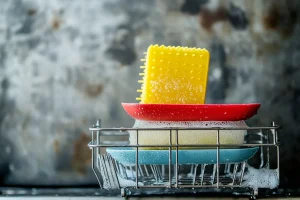 Navigating the diverse landscape of dishwashing products becomes significantly easier with an understanding of how they work and what distinguishes them. Manual dish soaps, available as liquids or solids, rely primarily on surfactants and scrubbing action, balancing cleaning power with skin mildness.
Navigating the diverse landscape of dishwashing products becomes significantly easier with an understanding of how they work and what distinguishes them. Manual dish soaps, available as liquids or solids, rely primarily on surfactants and scrubbing action, balancing cleaning power with skin mildness.
Automatic dishwasher detergents, in powder, liquid, gel, tablet, or pod form, employ a low-foaming blend of enzymes, builders, and specialized surfactants, tailored for the high-heat, high-pressure environment of a machine. Critically, these two categories are not interchangeable due to fundamental differences in formulation, particularly regarding foaming properties.
Beyond the primary detergent, auxiliary products like rinse aids (for spot-free drying), dishwasher cleaners (for machine maintenance), and pre-soak aids (for tough, baked-on food) play crucial roles in achieving consistently optimal results, especially in challenging conditions like hard water areas.
Choosing the right products involves considering effectiveness for typical soil levels, formulation preferences (eco-friendly, sensitive skin), water hardness, environmental impact of packaging and ingredients, cost-effectiveness, and appliance compatibility.
Armed with this knowledge, consumers can make informed decisions, selecting the products that best suit their needs, budget, and values. Understanding the tools available – from the science of surfactants and enzymes to the practicalities of different product formats and the benefits of essential aids – empowers users to achieve sparkling clean dishes efficiently and effectively.
Recognizing when a task requires the expertise and resources of professional cleaners further completes the picture, ensuring the best possible approach to maintaining a clean and healthy home.




